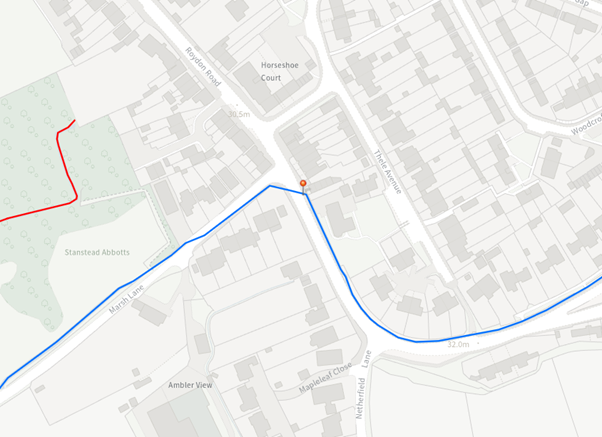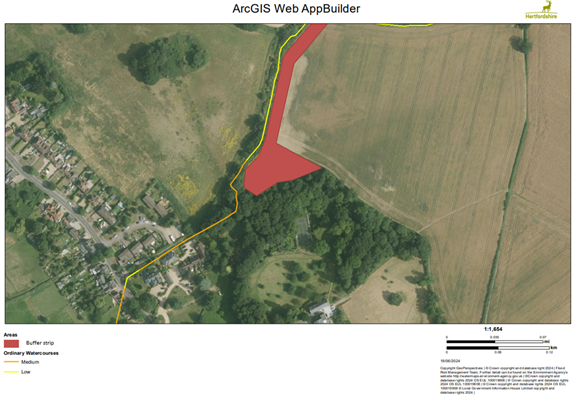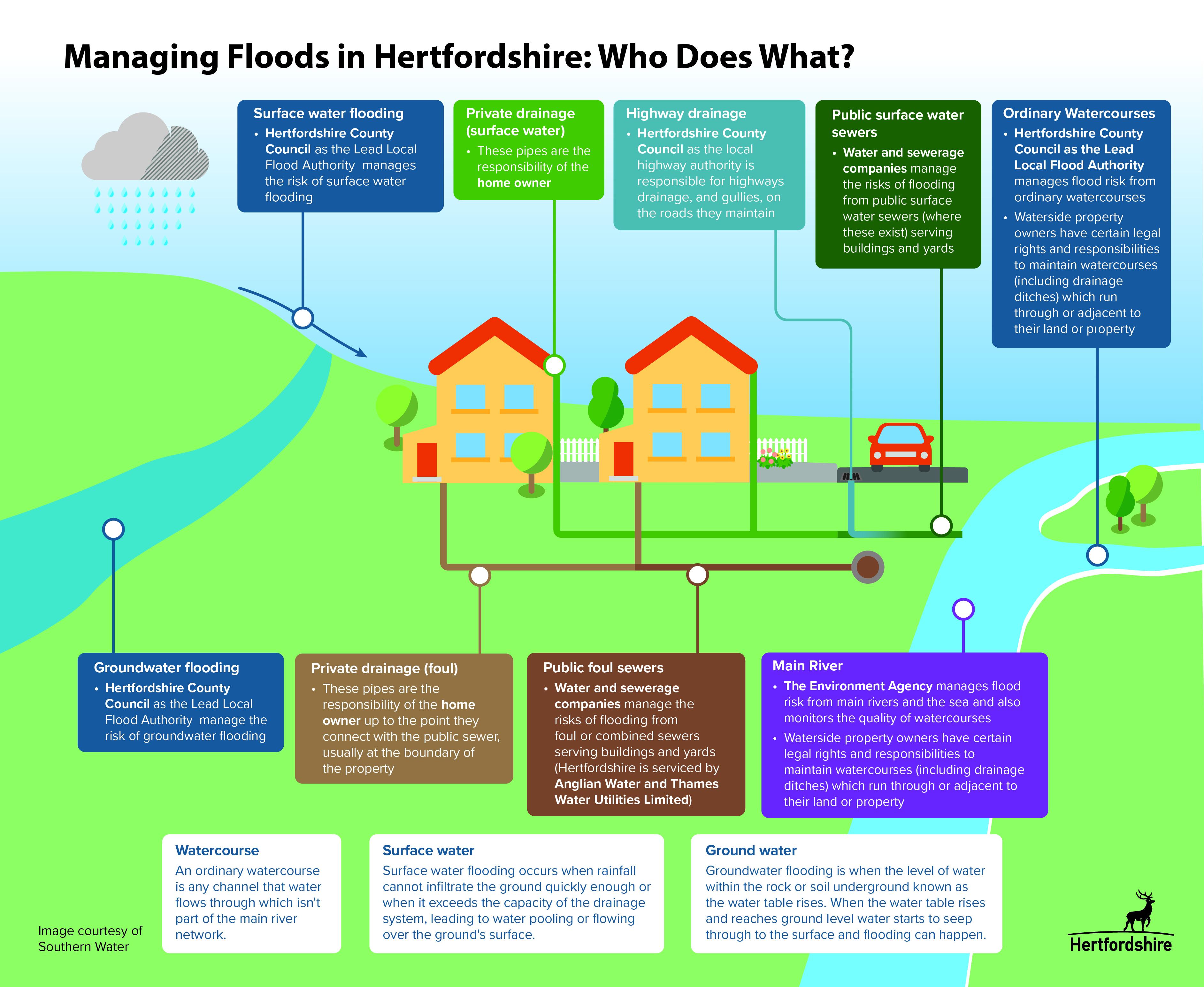Stanstead Abbotts Drain Information Page
Overview
Last updated 20 June 2025
We have created this information page to keep residents informed of current and future developments to the Stanstead Abbotts Drain. We will be updating this page as the project progresses.
Maintenance of Stanstead Abbotts Drain
Since 2024, the Environment Agency have increased their maintenance of Stanstead Abbotts Drain from once to twice per year. This usually takes place in February and September.
The Environment Agency will continue weekly planned visits to inspect and clear the Stanstead Abbotts Drain trash screen at Roydon Road.
Property Flood Resilience update - 20 June 2025
Lakeside have issued ‘Schedule of Works’ to all residents signed up to the scheme. Please contact Lakeside directly if you would like to discuss your product selections.
Note: All ingress points identified in either options A or B of your ‘schedule of works’ will need to be protected to be eligible for the grant funding.
If you wish to accept only some PFR measures, sufficient justification will be required. It may be acceptable if it can be demonstrated that flood waters do not reach the part of the property where you do not wish to have PFR, or that there are already suitable PFR measures in place. This detail will be included in your homeowner legal agreement which you will be required to sign.
Next steps
Partnership working
- Hertfordshire County Council (HCC) as the highway authority, HCC as the Lead Local Flood Authority and the Environment Agency (EA) will be attending regular multi-agency meetings (MAM). Progress and updates will be reported back to residents on this webpage. A representative from East Herts District Council will also be invited to attend.
- The Environment Agency and Lead Local Flood Authority met on site with a Stanstead Abbotts Flood Warden to discuss what support that they and others can provide.
Flood Kits
- The storage has been ordered and awaiting delivery. Once the storage has been supplied and built, we will look to deliver the flood kit products to the community.
- All areas engaged with in Stanstead Abbotts have created a community flood plan. We advise residents involved in the creations of these to share the plan with the residents who were not able to make the engagement event and continue tailoring the plan to what works for the community.
Stanstead Abbotts Drain
- There have been reports from residents of potential blockages at the location identified by the red pin in the map below. This is where the river becomes culverted. A CCTV survey was completed by Hertfordshire Highways in February 2024 and the culvert was found to have no structural issues or blockages.
-
The Environment Agency have created a portal for residents to view the CCTV camera focussed on the trash screen at Roydon Road. Please use the following link: https://telemetry-data.com/open?profile=StansteadAbbotts
The camera updates every hour and can support up to 10 users at a time.
A new level monitoring site has been installed on Stanstead Abbotts Drain and is expected to be operational in the next few months.

Hertfordshire Highways
- In 2024, additional gullies were proposed for construction at the T-junction of Marsh Lane and Roydon Road. However, design efforts have been significantly constrained by the high concentration of underground utility lines at this location. Following extensive assessment, it is now considered unlikely that the gullies can be implemented unless the utilities are re-routed—an option that is unlikely to happen due to all the houses connected to these utilities. Should circumstances change, this page will be updated accordingly.
-
Proposals for the 20mph are being amended and reduced in extents on Roydon Road in order that there is not traffic calming required in the areas affected by flooding.
-
Roydon Road and Hunsdon Road are on an 18-month cleaning schedule, with the gullies last cleaned on 16 December 2023. The next scheduled clean for these gullies will be July-September 2025. Residents are able to access a map on the HCC website that allows them to see the gully cleaning schedule for the gullies in their area, please see map here:- Highways Assets Viewer or click this website: Maps and geographic information | Hertfordshire County Council and select Highways Assets Viewer.
-
If you spot gullies in the road that are blocked we advise you to report it through the Highways reporting service, which can be found here: - What type of flooding or drainage fault is it? | Hertfordshire County Council
Natural Flood Management
- The leaky barriers proposed on the Stanstead Abbots Drain are being progressed. The designs have been completed and the Environment Agency are working to now complete the final steps so that construction of these can take place. The earliest these barriers will be constructed in autumn 2025. Works cannot commence before bird nesting season ends in August. The EA are currently obtaining a permit which is required to carry out the works, and in the process of appointing a contractor to install the leaky barriers.
Street cleansing
- East Herts District Council (EHDC) and North Herts District Council (NHDC) waste team have a delegated cleansing team which covers East Hertfordshire and North Hertfordshire. The waste team will attend regular Multi-agency meetings and continue to engage with the EA and other partner agencies on a best response to resolve highlighted areas of concern.
- In conjunction with their contractor, EHDC continue to provide a regular cleanse to the districts following a schedule. A winter maintenance programme has been established to highlight any areas of which have additional requirements.
- On receipt of flood alerts or reports of flooding from the Environment Agency or Hertfordshire County Council, EHDC will provide additional inspections and prioritise cleansing in areas if there could be any detrimental impacts due to street cleansing.
-
Currently, street cleansing will commence as usual, but could experience a change in schedule due to a new contractor coming in. However, our expectations are that if a street falls below the agreed standard cleansing will take place.
-
In light of discussions with residents regarding street cleaning please see details below on how to report issues post flood-event:
Number: 01279 655261
Email: customer.services@eastherts.gov.uk
App: FixMyStreet- FixMyStreet
Cappell Lane
- The LLFA are working with riparian owners of the ordinary watercourse by Cappell Lane to clear any debris. Once this has been done the LLFA will carry out a topographic survey which will then inform the design and construction of the leaky barriers.
- On the 11th March a topographical survey of the ordinary watercourse was completed which will be used to inform the design of the leaky dams. Currently, we are agreeing a contract with our consultants which will then lead to the design of the leaky barriers starting. Currently, the timeline for completion of the designs is end of July, we will continue to update residents if this changes due to unforeseen circumstances.
- Hertfordshire County Council are officially in contract with a consultant for the designs of the leaky dams for the ordinary watercourse located on Cappell Lane. The designs should be completed by end of July 2025.
 Above: Existing 'buffer strip'
Above: Existing 'buffer strip'
Roles and Responsibilities
There are many organisations involved in managing flood risk. We have put together this diagram to help residents understand who is responsible for the different aspects of flooding and who to report issues to.

Flood risk in Stanstead Abbotts
Stanstead Abbotts has a history of flooding. Most notably in the winter 2013/14, the community experienced extreme weather resulting in significant flooding from the Stanstead Abbotts Drain and surface water. Several properties were flooded internally.
Flooding was exacerbated by large amounts of debris collecting on the trash screen underneath Roydon Road. High rainfall and debris caused the river to overflow.
Surface water flooding was also exacerbated by this event as well as the high level of rainfall in the area which meant the highway network was not able to cope, allowing water to follow the natural topography in the area to low spots and spill over onto properties.
What are the Environment Agency and Hertfordshire County Council proposing?
The Environment Agency are investigating Natural Flood Management opportunities on the upper reaches of Stanstead Abbotts Drain.
What is property flood resilience (PFR)?
PFR is a combination of products installed at your property to make it more resilient to flooding. PFR is tailored to each individual property.
Examples of PFR products include:
- Flood doors or barriers to reduce the amount of water entering your property.
- Automatic closing airbricks which close to prevent water from entering the property.
- Non-return valves fitted to pipes which exit the property, ensuring wastewater only flows in one direction and prevents backflow.
- Wall defence such as water sealants, re-pointing and rendering.
- Pumps to remove water.
PFR products offer an alternative and more permanent means for homeowners to manage their flood risk, without having to rely on sandbags. They are cost-effective and easy to implement, providing peace of mind and helping to reduce the stress and damage that flooding causes.
For further information on PFR you can visit https://consult.environment-agency.gov.uk/hnl/propertyfloodresilience/
How will the scheme work?
- In 2023 eligible residents were invited to complete an application form to register for a free initial PFR property survey.
- The Environment Agency have appointed a surveyor (JBA consulting) to attend properties in May / June 2024 to confirm if the property is suitable for PFR and which products are recommended.
- Should residents wish to proceed, the Environment Agency will appoint a supplier to install the chosen products. The Environment Agency will pay up to £8,000 towards these costs.
- Once installed, a post installation survey will be carried out to ensure the PFR products have been installed correctly.
Please note, if you prefer a flood door, these will be made of either UPVC or Composite materials. We are not likely to offer timber doors for this scheme due to reliability issues and the prohibitive costs of manufacture. You will have the chance to discuss these options during the product survey visit.
How do I find out more?
For more detailed information on the PFR process you can download the ‘Frequently Asked Questions’ document below.
Building your flood resilience
You can take steps now to better prepare yourself for flooding and make your home more resilient. Being resilient means you are more in control. It reduces the time spent out of the house because of flooding, and the stress and upheaval of being away from your home, work and community.
- Sign up to our flood warnings: www.gov.uk/sign-up-for-flood-warnings
- Prepare a personal flood plan and be assured of what to do if it floods: Personal flood plan - GOV.UK (www.gov.uk)
- Prepare a community flood plan and work alongside your neighbours to better prepare for, respond to and recover from flood events: Community flood plan template - GOV.UK (www.gov.uk)
Incident Response
The Environment Agency operates 24/7 incident response to monitor and attend the area for flood risk management when required. This includes remote monitoring of the Stanstead Abbotts Drain trash screen via CCTV.
In the event of a blockage in the watercourse or immediate flood risk please notify the Environment agency using the Environment Agency incident hotline on 0800 80 70 60.
Give us your views
This is an information page only and is not being used for online consultation
For more information about this project, please contact PSO-HNL@environment-agency.gov.uk
You can also find out more about PFR on the National Flood Forum’s website
Audiences
- Members of the public
- Elected representatives, including MPs
- Local councils
- Environment Agency customers
Interests
- Flood management
- Specific projects, issues, or activity pages

Share
Share on Twitter Share on Facebook